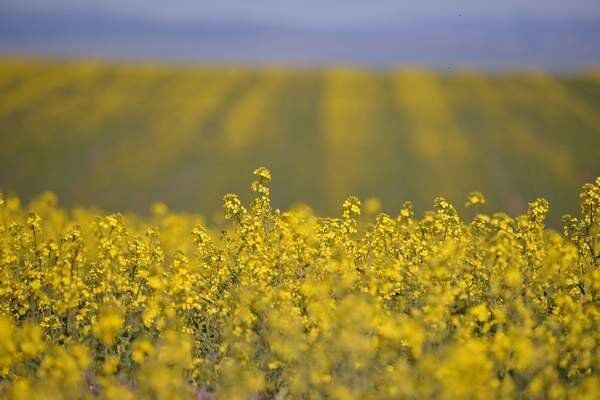Oregon canola bill escapes deadline, but its outlook is uncertain
Published 6:00 pm Thursday, May 18, 2023

- Oregon lawmakers will have until the end of the 2023 legislative session to decide whether to permanently restrict canola to 500 acres in the Willamette Valley.
The outlook a proposal to permanently restrict canola to 500 acres in Oregon’s Willamette Valley remains uncertain, despite its survival of a final legislative deadline.
Trending
Lawmakers will potentially have until the end of the legislative session, which must end June 25, to decide the fate of the maximum acreage cap proposed in Senate Bill 789.
On May 18, the House Agriculture Committee voted 5-4 to refer the bill without recommendation to the House Rules Committee, which isn’t subject to legislative deadlines.
The referral spared SB 789 from this year’s fourth and final legislative deadline on May 19, which would have killed the proposal unless it was approved for a floor vote.
Trending
Proponents of making the 500-acre limit permanent claim any additional canola acreage would imperil the region’s specialty seed industry by endangering the genetic purity of related crops through cross pollination.
Rep. Anna Scharf, R-Amity, said she hoped a work group will be formed to seek a more durable solution to the controversy between canola and specialty seed producers.
“The coexistence issue has to be resolved by legislation,” she said. “I believe we can grow both of these industries.”
Delegating canola production rules to the Oregon Department of Agriculture proved untenable in the past, while passing the 500-acre limit would only invite future legislation to repeal it, Scharf said.
Making the acreage cap permanent would also send a bad message that agricultural research from Oregon State University isn’t worthy of respect, she said.
“That really hurts because we have some amazing scientists working there,” Scharf said.
Scharf previously proposed several revisions to SB 789 that would gradually expand the region’s canola production, up to 7,000 acres or 15,000 acres, until removing the acreage restriction in nine years.
However, none of those options were voted on by the House Agriculture Committee, or even discussed during the work session May 19.
Rep. Ken Helm, D-Beaverton, said any amendments were prevented by the “elephant in the room,” referring to a Republican protest that’s halted legislation from moving through the Senate.
Any revisions to SB 789 in the House couldn’t go back to the Senate for concurrence until the chamber has enough lawmakers for a quorum, which isn’t certain to happen, he said.
Several lawmakers on the House Agriculture Committee signaled they were disappointed with the bill’s approach of curtailing one type of farming for the benefit of another.
“I think it’s important for us not to make winners and losers,” said Rep. Susan McLain, D-Hillsboro.
Rep. Annessa Hartman, D-Gladstone, said she wouldn’t have voted to approve the bill for a House floor vote.
She urged a non-political solution that’s transparent and provides equal treatment for all growers, which will take more work.
“There are clear holes on both sides of the story,” Hartman said.
Rep. Bobby Levy, R-Echo, said that Oregon derives a huge benefit from being a “right to farm” state, referring to a law that protects agricultural practices from lawsuits and restrictions.
“When we start messing with that right to farm, it prevents everyone from being successful, not just one person,” she said.
Several lawmakers said that any solution to the problem would need to involve a public pinning system to prevent pollination between related crops. Currently, the state relies on a map maintained by a private seed industry group.
“I don’t think there’s a magic number of canola acres in the Willamette Valley,” said Rep. Mark Gamba, D-Milwaukie.
Proper isolation distances are more relevant than acreage, since a large field of canola located far from any related vegetable seed production would be less risky than smaller fields nearby, said Rep. Mark Owens, R-Crane.
“An arbitrary number doesn’t solve the issue of coexistence,” he said.
Recurring debates over canola production in the Legislature began a decade ago, when lawmakers first adopted the acreage limit to facilitate an Oregon State University study on the crop’s pest, disease and cross-pollination impacts.
Though the study found canola wasn’t more hazardous to the region’s specialty seed industry than radishes or turnips, which are also related brassica species, opponents have remained determined to block more widespread production of the crop.
Lawmakers heard many of the same arguments over canola production this year as during previous discussions about extending the 500-acre limit in 2015 and 2019.
Supporters of increased acreage cite canola’s value as a rotation crop that can earn decent prices while interrupting pest and disease problems in grass seed fields.
Detractors claim its potential to genetically contaminate brassica vegetable crops, including cabbage, broccoli, kale and cauliflower, will damage the Willamette Valley’s international standing as a source of high-value seeds.








